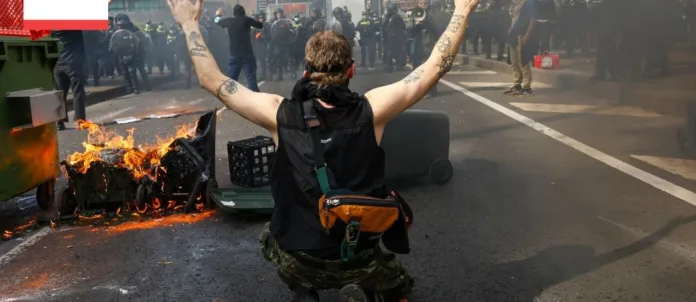Heightened security measures mark the second day of protests against the Land Forces international land defence expo in Melbourne, following violent clashes
On the second day of protests against the Land Forces International Land Defence Expo in Melbourne, police expanded barricades and conducted thorough searches of protesters. This followed a day of violent clashes between activists and police.
The day began quietly with a lone protester holding a silent vigil outside the Melbourne Convention and Exhibition Centre. Soon after, about 100 protesters marched from Southern Cross Station, chanting slogans like “Free, free Palestine” and “From the river to the sea, Palestine will be free.” They blocked traffic on Flinders Street, prompting police to use sirens to move the group towards Spencer Street Bridge. Despite road closures, the demonstrators marched east down Flinders Street, crossing under the rail viaduct and over the Yarra River.
Hundreds of police officers, including mounted police and those in riot gear, kept the group, which grew to about 200, away from the convention centre. At 9:15 am, a brief stand-off occurred outside Crown Casino, where a man with a megaphone criticized the authorities and media while a demonstrator waved a Palestinian flag.
As police blocked access to Clarendon Street from Yarra Promenade, the protesters circled the casino, attempting to approach the expo from the south. At Whiteman Street, police searched backpacks and pockets, using metal-detecting wands to scan for weapons. An officer instructed anyone wearing a face covering to leave the area.
One young protester reported being searched three times in 15 minutes, feeling targeted due to his height. He described the police as aggressive, recounting how he was repeatedly questioned and told to stop “eyeballing” officers. Another protester accused a television network’s security guard of assault during a confrontation with the media.
By 11 am, the crowd had dispersed. Meanwhile, inside the convention centre, lobbyists, weapons makers, and military officials continued their activities, undisturbed by the protests outside.
Analysis
Political
The heightened security and police actions during the protests reflect the government’s commitment to maintaining order during high-profile events. However, the aggressive policing tactics and the focus on anti-war protesters could draw criticism from civil rights groups and opposition parties. The government’s handling of the protests may influence public opinion and political discourse around freedom of assembly and expression.
Social
Socially, the protests highlight the ongoing tensions between anti-war activists and the defence industry. The demonstrators’ chants and actions underscore their opposition to military activities and support for causes like Palestinian liberation. The police’s response, including searches and barricades, raises questions about the balance between security and civil liberties. The public’s reaction to these events could shape future discussions on protest rights and law enforcement practices.
Economic
Economically, the protests and the subsequent police response have implications for the city’s resources and the defence expo itself. The increased security measures and potential disruptions to traffic and business activities could impact local commerce. Additionally, the defence expo, which attracts international attention and investment, may face scrutiny and potential backlash from those opposed to the arms industry. The economic benefits of hosting such events must be weighed against the social and political costs.
